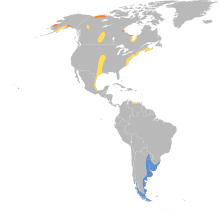Hudsonian godwit
| Hudsonian godwit | |
|---|---|

| |
| A non-breeding vagrant at Kogarah Bay, Australia | |

| |
| Male in breeding plumage, Churchill, Canada | |
| Scientific classification | |
| Domain: | Eukaryota |
| Kingdom: | Animalia |
| Phylum: | Chordata |
| Class: | Aves |
| Order: | Charadriiformes |
| Family: | Scolopacidae |
| Genus: | Limosa |
| Species: | L. haemastica
|
| Binomial name | |
| Limosa haemastica | |

| |
| Synonyms | |
| |
The Hudsonian godwit (Limosa haemastica) is a large shorebird in the sandpiper family, Scolopacidae. The genus name Limosa is from Latin and means "muddy", from limus, "mud". The specific haemastica is from Ancient Greek and means "bloody". An 18th-century name for this bird was red-breasted godwit. The English term "godwit" is believed to imitate the bird's call.
Taxonomy
[edit]The Hudsonian godwit was formally described in 1758 by the Swedish naturalist Carl Linnaeus in the tenth edition of his Systema Naturae. He placed it in the genus Scolopax and coined the binomial name Scolopax haemastica.[2] Linnaeus based his entry on the "red-breasted godwit" that had been described and illustrated in 1750 by the English naturalist George Edwards in the third volume of his A Natural History of Uncommon Birds. Edwards had obtained a specimen that had been collected in the Hudson Bay region of Canada by James Isham, an employee of the Hudson's Bay Company. [3] Linnaeus specified the type locality as North America but this is restricted to the Hudson Bay following Edwards.[4] The Hudsonian godwit is now one of four species placed in the genus Limosa that was introduced in 1760 by French zoologist Mathurin Jacques Brisson. The species is considered to be monotypic: no subspecies are recognised.[5] The genus name Limosa is from Latin and means "muddy", from limus, "mud". The specific epithet haemastica is from Ancient Greek haimatikos meaning "bloody".[6] The English name "godwit" was first recorded in about 1416–17 and is believed to imitate the bird's call.[7]
Description
[edit]Adults have long dark legs and a long pink bill with a slight upward curve and dark at the tip. The upper parts are mottled brown and the underparts are chestnut. The tail is black and the rump is white. They show black wing linings in flight. The legs and feet are bluish-grey.[8]
| Standard Measurements[8][9] | |
|---|---|
| length | 14.5–16.7 in (370–420 mm) |
| weight | 300 g (11 oz) |
| wingspan | 29 in (740 mm) |
| wing | 195.5–208.5 mm (7.70–8.21 in) |
| tail | 70–83.8 mm (2.76–3.30 in) |
| culmen | 68.2–81.2 mm (2.69–3.20 in) |
| tarsus | 53.5–59.5 mm (2.11–2.34 in) |
Breeding
[edit]Their breeding habitat is the far north near the tree line in northwestern Canada and Alaska, also on the shores of Hudson Bay. They nest on the ground, in a well-concealed location in a marshy area. The female usually lays 4 olive-buff eggs marked with darker splotches. Incubation period is 22 days.[8] Both parents look after the young birds, who find their own food and are able to fly within a month of hatching.
Migration
[edit]They migrate to South America and the Caribbean. These birds gather at James Bay before fall migration. In good weather, many birds make the trip south without stopping. They are vagrants to Europe, Australia, and South Africa.
They can perhaps be most easily seen in migration on the east coast of North America where they can be plentiful in migration in late July through early August.
Diet
[edit]These birds forage by probing in shallow water. They mainly eat insects and crustaceans.
Conservation history
[edit]Their numbers were reduced by hunting at the end of the 19th century.
References
[edit]- ^ BirdLife International (2016). "Limosa haemastica". IUCN Red List of Threatened Species. 2016: e.T22693154A93386036. doi:10.2305/IUCN.UK.2016-3.RLTS.T22693154A93386036.en. Retrieved 19 November 2021.
- ^ Linnaeus, Carl (1758). Systema Naturae per regna tria naturae, secundum classes, ordines, genera, species, cum characteribus, differentiis, synonymis, locis (in Latin). Vol. 1 (10th ed.). Holmiae (Stockholm): Laurentii Salvii. p. 147.
- ^ Edwards, George (1750). A Natural History of Uncommon Birds. Vol. 3. London: Printed for the author at the College of Physicians. p. 138, Plate 138.
- ^ Peters, James Lee, ed. (1934). Check-List of Birds of the World. Vol. 2. Cambridge, Massachusetts: Harvard University Press. p. 263.
- ^ Gill, Frank; Donsker, David; Rasmussen, Pamela, eds. (December 2023). "Sandpipers, snipes, coursers". IOC World Bird List Version 14.1. International Ornithologists' Union. Retrieved 14 August 2024.
- ^ Jobling, James A. (2010). The Helm Dictionary of Scientific Bird Names. London: Christopher Helm. pp. 227, 184. ISBN 978-1-4081-2501-4.
- ^ "Godwit". Oxford English Dictionary (Online ed.). Oxford University Press. (Subscription or participating institution membership required.)
- ^ a b c Godfrey, W. Earl (1966). The Birds of Canada. Ottawa: National Museum of Canada. p. 163.
- ^ Sibley, David Allen (2000). The Sibley Guide to Birds. New York: Knopf. p. 177. ISBN 0-679-45122-6.
External links
[edit]- Hudsonian godwit - Limosa haemastica - USGS Patuxent Bird Identification InfoCenter
- Hudsonian godwit Species Account - Cornell Lab of Ornithology
- "Hudsonian godwit media". Internet Bird Collection.
- Hudsonian godwit photo gallery at VIREO (Drexel University)
- Interactive range map of Limosa haemastica at IUCN Red List maps
- Audio recordings of Hudsonian godwit on Xeno-canto.

